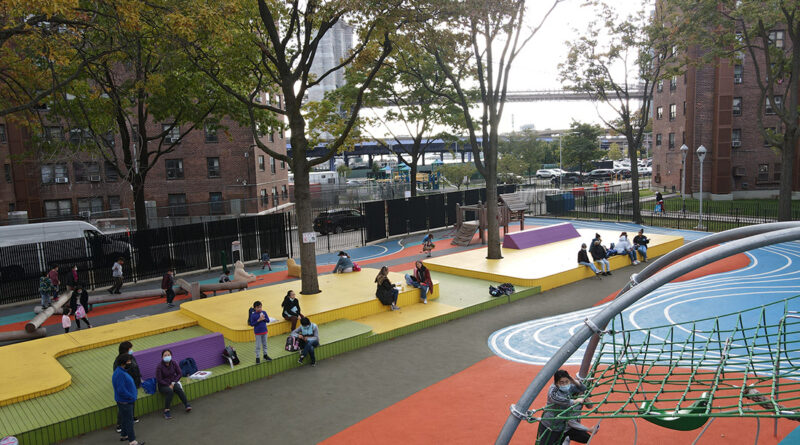NYCHA’s Open Space Masterplan Recognized by the American Society of Landscape Architects
A landscape architecture and urban design firm has been recognized by the American Society of Landscape Architects (ASLA) for its contributions to two NYCHA initiatives, including the Open Space Masterplan.
NYCHA partner Grain Collective, a minority- and women-led firm, was selected by ASLA’s New York City chapter to receive Merit Awards honoring the firm’s site analysis work on NYCHA’s Open Space Masterplan as well as its resident engagement efforts for the restoration of the playground at Alfred E. Smith Houses in Manhattan. The awards, which recognize excellence in landscape architecture, will be presented on April 13 at Manhattan’s Center for Architecture.
The Authority’s Open Space Masterplan is a comprehensive framework and toolkit for reimagining the outdoor spaces at 133 developments across the Authority. The project emphasized the fact that 73 percent of residents are over the age of 18 but only 3.5 percent of active recreation areas at NYCHA are designed for that age group. Grain Collective worked with the Authority to collect resident input and conceive open space designs for encouraging active and passive recreation across all age groups, while leveraging existing NYCHA landscape features to better connect residents to surrounding community amenities.
“We have worked diligently to solicit the perspective of knowledgeable partners who can help the Authority conceive of new ways to utilize public-facing assets,” said NYCHA Chair & CEO Greg Russ. “Grain Collective’s recognition by the American Society of Landscape Architects is a testament to the quality work it has done on NYCHA’s behalf and speaks to the firm’s leadership in urban planning and design.”
“NYCHA has facilitated dozens of partnerships with public, private, and nonprofit organizations around the overarching goal of improving the quality of open spaces at our developments,” said NYCHA Executive Vice President of Capital Projects Steve Lovci. “The community planning and site analysis campaign conducted for the Open Space Masterplan provides a vision for a more active and more connected NYCHA, reflecting the best practices in urban design today.”
In March 2020, NYCHA engaged landscape architecture and design firms to undertake the ambitious task of creating an open space master plan for 133 developments in the NYCHA portfolio. Grain Collective’s urban design campaign comprised data analyses, on-the-ground field research (including resident and staff interviews), and site assessments.
The findings were then incorporated into a revised concept design that reflected the application of open space planning principles and provided a vision for realizing the full experiential potential of each NYCHA campus. As part of that effort, Grain Collective helped develop high-level cost estimates on potential play space projects at different scales. These schematics were not designed to be a replacement strategy for the spaces that currently exist but rather a comprehensive reevaluation of how entrances, walkways, central greens, and other public-facing areas can be repurposed to facilitate healthy recreational activity.
“The collection of public areas at NYCHA campuses across New York City offer a gamut of experientially diverse environments that speak to the vast potential of open space equity and design – which informs so much of our practice,” said Grain Collective Director of Landscape Architecture Kate Belski. “We are honored that the American Society of Landscape Architects recognized the active design principles and connected community-building efforts that form the backbone of the Open Space Masterplan, and to NYCHA for its partnership on this vital initiative.”
Additionally, Grain Collective was also honored with an ASLA Merit Award for its role in facilitating a resident-informed restoration of the playground at Alfred E. Smith Houses. In that role, the firm worked to gather significant feedback from residents on playground equipment, seating color preferences, and play area age ranges through several design charrettes. With that information, it helped oversee the construction of a multi-generational, two-way play space that accommodates the needs of children, young people, and seniors. The materials incorporated recycled plastic lumber that is non-toxic and long-lasting.










